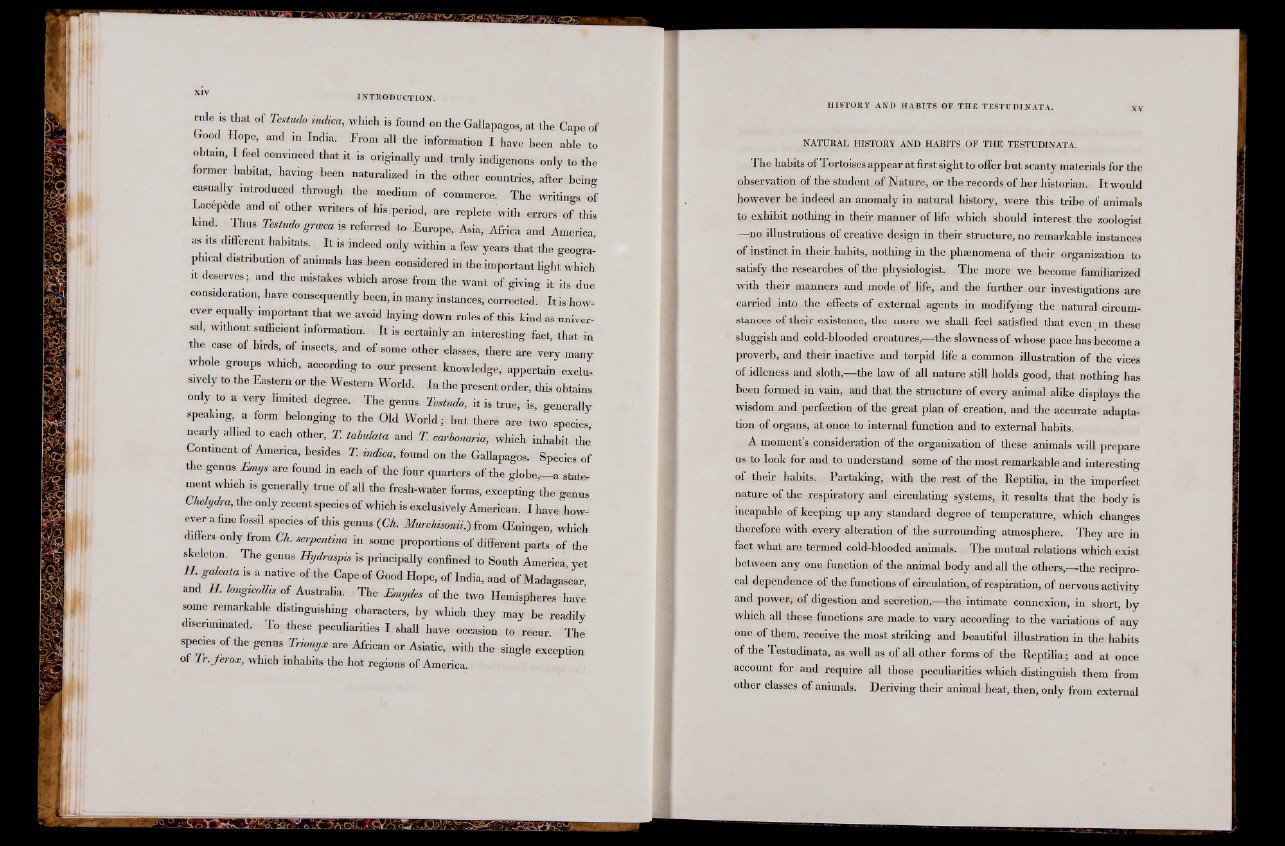
rule is that of Testudo indica, which is found on the Gallapagos, at the Cape of
Good Hope, and in India. From all the information I have been able to
obtain, I feel convinced that it is originally and truly indigenous only to the
former habitat, having been naturalized in the other countries, after being
casually introduced through the medium of commerce. The writings of
Lacépéde and of other writers of his , period, are replete with errors of this
kind. Thus Testudo grwca is referred to Europe, Asia, Africa and America
as its different habitats. It is indeed only within a few years that the geographical
distribution of animals has been considered in the important light which
it deserves; and the mistakes which arose from the want of giving it its due
consideration, have consequently been, in many instances^ corrected. Itis however
equally important that We avoid laying down rules of this kind as universal,
without sufficient information. It is certainly an interesting fact, that in
the case of birds, of insects, and of some other classes, there are very many
whole groups which, according to our present: knowledge, appertain exclusively
to the Eastern or the Western World. In the present order, this obtains
only to a very limited degree. The genus. Testudo, it is true; ds, generally
speaking, a form belonging to the Old World; but there are two species;
neariy allied to each other, T. tabulata and T. carbonaria, which inhabit the”
Continent of America, besides T. indica, found on the Gallapagos. Species of
the genus Emys are found in each of the four quarters of the globe,—a state,
ment which is generally true of all the fresh-water forms, excepting the. genus
Chelydra, the only recent species of which is exclusively American, I have however
a fine fossil species of this genus (Ch. Murchisonii,) frpm CEningen, which
differs only from Ch. serpentina in some proportions of different parts of the
skeleton. The genus Hydraspis is principally confined to South America, yet
H. galeota is a native of the Cape of Good Hope, of India, and of Madagascar
and H. longicollis of Australia, The Emydes of the two Hemispheres have
some remarkable distinguishing characters, by which they may be readily
discriminated. To t h e s e peculiarities I shall have occasion to recur. T h e
species of the genus Trionyx are African or Asiatic, with the single exception
of Tr.ferox, which inhabits the hot regions of America.
HISTORY A N D HABIT S OF THE TESTUDINATA. XV
N A T U R A L H IS T O R Y A N D H A B IT S O F T H E T E S TU D IN A TA .
The habits of Tortoises appear at first sight to offer but scanty materials for the
observation of the student of Nature, or the records of her historian. It would
however be indeed an anomaly in natural history, were this tribe of animals
to exhibit nothing in their manner of life which should interest the zoologist
—no illustrations of creative design in their structure, no remarkable instances
of instinct in their habits, nothing in the phænomena of their organization to
satisfy the researches of the physiologist. The more we become familiarized
with their manners and mode of life, and the further our investigations are
carried into the effects of external agents in modifying the natural circumstances
of their existence, the more we shall feel satisfied that even in these
sluggish and cold-blooded creatures,—the slowness of whose pace has become a
proverb, and their inactive and torpid life a common illustration of the vices
of idleness and sloth,—the law of all nature stiff holds good, that nothing has
been formed in vain, and that the structure of every animal alike displays the
wisdom and perfection of the great plan of creation, and the accurate adaptation
of organs, at once to internal function and to external habits.
A moment s consideration of the organization of these animals will prepare
us to look for and to understand some of the most remarkable and interesting
of their habits. Partaking,' with the rest of the Reptilia, in the imperfect
nature of the respiratory and circulating systems, it results that the body is
incapable of keeping up any standard degree of temperature, which changes
therefore with every alteration of the surrounding atmosphere. They are in
fact what are termed cold-blooded animals. The mutual relations which exist
between any one function of the animal body and all the others,—the reciprocal
dependence of the functions of circulation, of respiration, of nervous activity
and power, of digestion and secretion,—the intimate connexion, in short, by
which all these functions are made to vary according to the variations of any
one of them, receive the most striking and beautiful illustration in the habits
of the Testudinata, as well as of all other forms of the. Reptilia ; and at once
account for and require all those peculiarities, which distinguish them from
other classes of animals. Deriving their animal heat, then, only from external